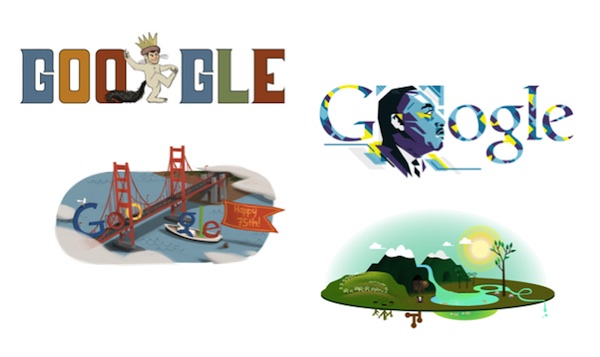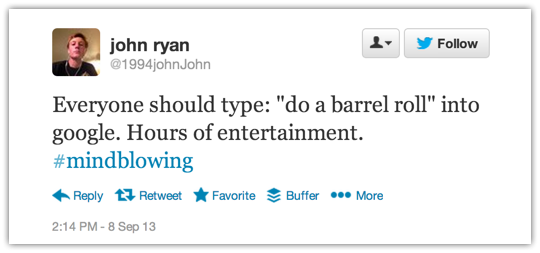Easter Egg Marketing: How Snapchat, Apple, and Google Hook You
This is a guest post by Ryan Hoover, the Director of Product at PlayHaven and creator of Startup Edition. Follow him Twitter at @rrhoover or visit his blog to read more on product design.
Ryan Hoover on Easter Egg Marketing
Last week I received this Snapchat from a friend:
I was quite surprised to see a black-and-white photo. “When did Snapchat add filters?” I asked in response.
With pride and delight, my friend responded with instructions: enter the text caption, “B&W…”, to activate the black-and-white filter. Grinning, I immediately sent a dozen B&W Snapchats to my friends, anticipating their curious replies because I knew something they did not. I knew a secret.
The black-and-white filter is one of Snapchat’s many Easter eggs. An Easter egg is an inside joke or hidden feature. The term was first coined by a programmer who hid his signature inside a secret room within the Atari 2600 video game, “Adventure”. Decades later, Easter eggs are a recurring meme in gaming, a head-nod to players, and have expanded into non-gaming, consumer products. Look closely and you may find Easter eggs hidden within your favorite applications.
The nature of Easter eggs is an oxymoron. Why would Snapchat or any other product hide functionality. Apps should be intuitive and accessible, right?
Easter eggs go against users’ expectations and in turn serve as a powerful form of marketing, enabling companies to:
- Get People Talking – People love knowing secrets but they like to share them even more. Consider the last time you heard office gossip or a twist ending to a much-anticipated film. Did you have an urge to tell others? Wasn’t it amusing to see your friend’s reaction as you revealed the secret?
- Bring People Together – As a child, we were told not to withhold secrets from our parents. But we did so anyway. Mutually shared secrets between our friends and siblings brought us together. The same is true for Easter eggs. Those aware of the Easter egg secret share a common understanding, separating people “in the know” from outsiders. This helps form a bond between holders of the secret and strengthens a community.
- Build a Brand – Easter eggs are fun and produce a “WOW!” effect. This delight forms a memorable connection between the brand and its users through a shared understanding not privy to everyone.
Here are three companies that use Easter eggs to spike engagement, establish a community, increase word-of-mouth, and build a memorable brand:
Apple (Siri)
When Siri launched, Easter eggs bombarded the internet. People could not get enough of Siri’s unexpected, witty answers to the hidden questions and phrases.
Siri’s humor was inescapable as blogs, TV shows, and social networks exploded in discussion. Websites dedicated to its Easter eggs sprung up. A Google search for “siri funny questions” results in over a million results. The free marketing instigated by these Easter eggs was arguably more impactful than Apple’s multi-million dollar advertising budget.
The secretive and clever nature of Easter eggs encouraged users to explore the product to uncover its secrets. When users cracked an Easter egg mystery, they acquired bragging rights, often sharing their discovery with friends. As a result, Siri became a celebrity as people promoted her wit.
Lyft
As I was walking down Howard St. in San Francisco, I overhead a group of people talking.
“What are those pink mustaches for?” A woman said, pointing to a blue sedan.
“I don’t know! I see them everywhere.” Her friend replied.
This wasn’t the first time I had heard this question. I observed two other groups of people ask the same question earlier that week.
Lyft, a ride-sharing service, aroused curiosity by decorating its fleet of vehicles with furry, pink mustaches. Instead of plastering its brand name on the side panels of its cars, Lyft used an Easter egg to catch people’s attention and get them talking. After seeing a half a dozen pink mustache-sporting vehicles, one is bound to resolve the mystery.
As users demonstrated an effort to understand the meaning behind the silly spectacle, by asking friends or searching online, Lyft became more memorable. This is especially important in competitive markets, where recall and top-of-mind-awareness determine which transportation service one turns to the moment they need a ride. Lyft creatively stood out from the competition by hiding its brand behind an Easter egg: a pink mustache.
Google
Google is known for its shenanigans and clever Easter eggs. The search goliath often replaces its logo with Google Doodles, turning its name into art in honor of holidays, special events, and anniversaries. The company even turned its logo into an interactive synthesizer and zamboni mini-game. These rotating doodles spur conversation and encourage people to visit the homepage to see what others are talking about.
Less obvious, though arguably more impactful, are Google’s hidden search terms. Visit google.com, type in “do a barrel roll”, and press enter! Be prepared for a delightful surprise as the screen rotates. This hidden gem continues to spread across the web years after its release in 2011, as evident by the hundreds of tweets like the one below, shared just this week.
Despite being a multi-billion dollar corporation, Google demonstrates playfulness, charming its users with fun surprises. Although Easter eggs provide no value to the product’s core offering, it creates a personality to the brand and encourages users to engage in marketing the product by forwarding it to friends.
Easter eggs are more than a fun distraction and can serve as a powerful form of marketing. Consider how you can incorporate Easter eggs in your product or service to increase engagement, establish a community, get people talking, and build a memorable brand.
And now that you know the secret, don’t you want to share it? ;)
For more essays on product design, subscribe to Ryan’s email list.
PS. Get new updates/analysis on tech and startupsI write a high-quality, weekly newsletter covering what's happening in Silicon Valley, focused on startups, marketing, and mobile.
Views expressed in “content” (including posts, podcasts, videos) linked on this website or posted in social media and other platforms (collectively, “content distribution outlets”) are my own and are not the views of AH Capital Management, L.L.C. (“a16z”) or its respective affiliates. AH Capital Management is an investment adviser registered with the Securities and Exchange Commission. Registration as an investment adviser does not imply any special skill or training. The posts are not directed to any investors or potential investors, and do not constitute an offer to sell -- or a solicitation of an offer to buy -- any securities, and may not be used or relied upon in evaluating the merits of any investment.
The content should not be construed as or relied upon in any manner as investment, legal, tax, or other advice. You should consult your own advisers as to legal, business, tax, and other related matters concerning any investment. Any projections, estimates, forecasts, targets, prospects and/or opinions expressed in these materials are subject to change without notice and may differ or be contrary to opinions expressed by others. Any charts provided here are for informational purposes only, and should not be relied upon when making any investment decision. Certain information contained in here has been obtained from third-party sources. While taken from sources believed to be reliable, I have not independently verified such information and makes no representations about the enduring accuracy of the information or its appropriateness for a given situation. The content speaks only as of the date indicated.
Under no circumstances should any posts or other information provided on this website -- or on associated content distribution outlets -- be construed as an offer soliciting the purchase or sale of any security or interest in any pooled investment vehicle sponsored, discussed, or mentioned by a16z personnel. Nor should it be construed as an offer to provide investment advisory services; an offer to invest in an a16z-managed pooled investment vehicle will be made separately and only by means of the confidential offering documents of the specific pooled investment vehicles -- which should be read in their entirety, and only to those who, among other requirements, meet certain qualifications under federal securities laws. Such investors, defined as accredited investors and qualified purchasers, are generally deemed capable of evaluating the merits and risks of prospective investments and financial matters. There can be no assurances that a16z’s investment objectives will be achieved or investment strategies will be successful. Any investment in a vehicle managed by a16z involves a high degree of risk including the risk that the entire amount invested is lost. Any investments or portfolio companies mentioned, referred to, or described are not representative of all investments in vehicles managed by a16z and there can be no assurance that the investments will be profitable or that other investments made in the future will have similar characteristics or results. A list of investments made by funds managed by a16z is available at https://a16z.com/investments/. Excluded from this list are investments for which the issuer has not provided permission for a16z to disclose publicly as well as unannounced investments in publicly traded digital assets. Past results of Andreessen Horowitz’s investments, pooled investment vehicles, or investment strategies are not necessarily indicative of future results. Please see https://a16z.com/disclosures for additional important information.






